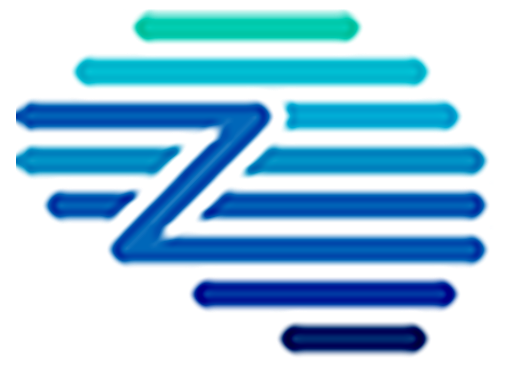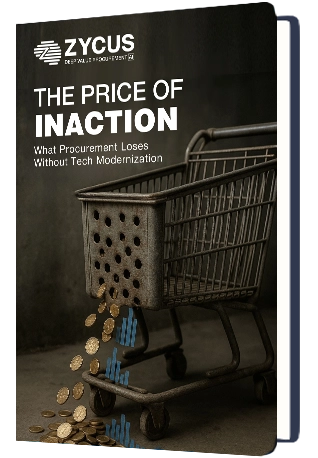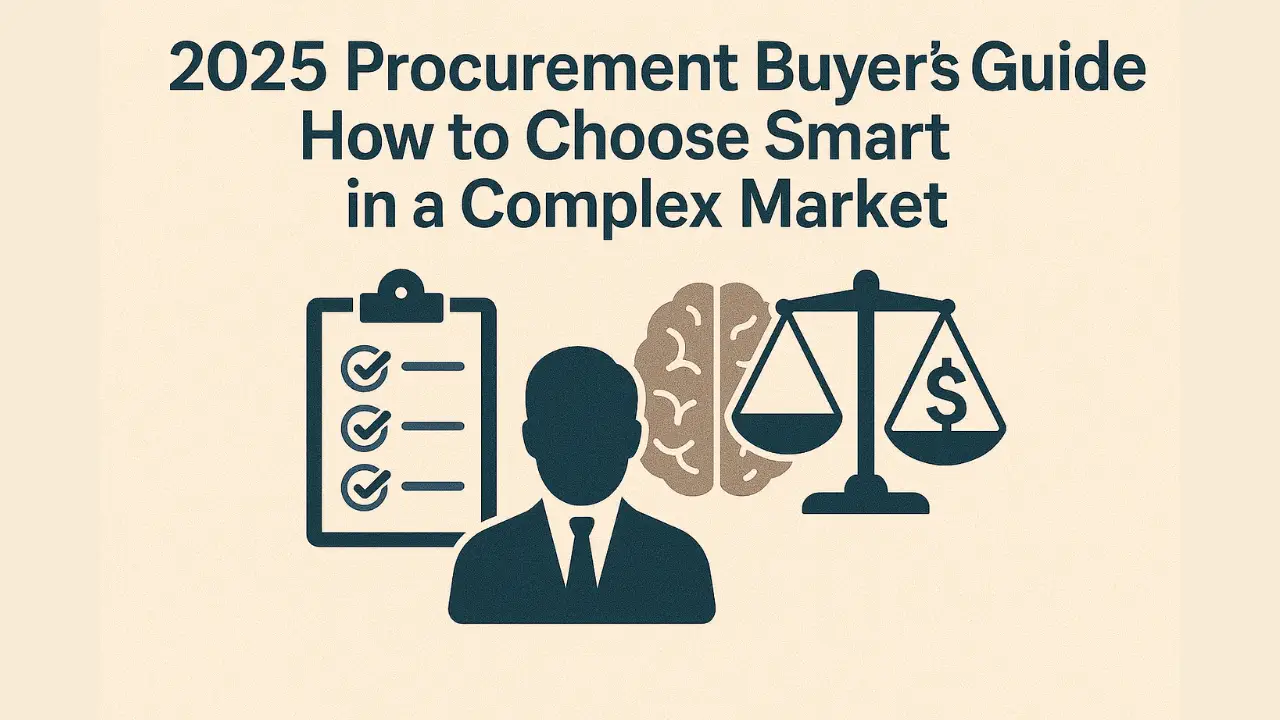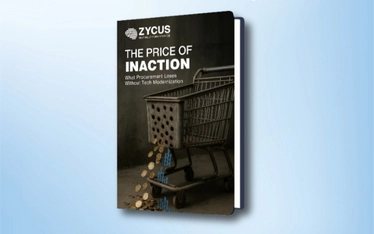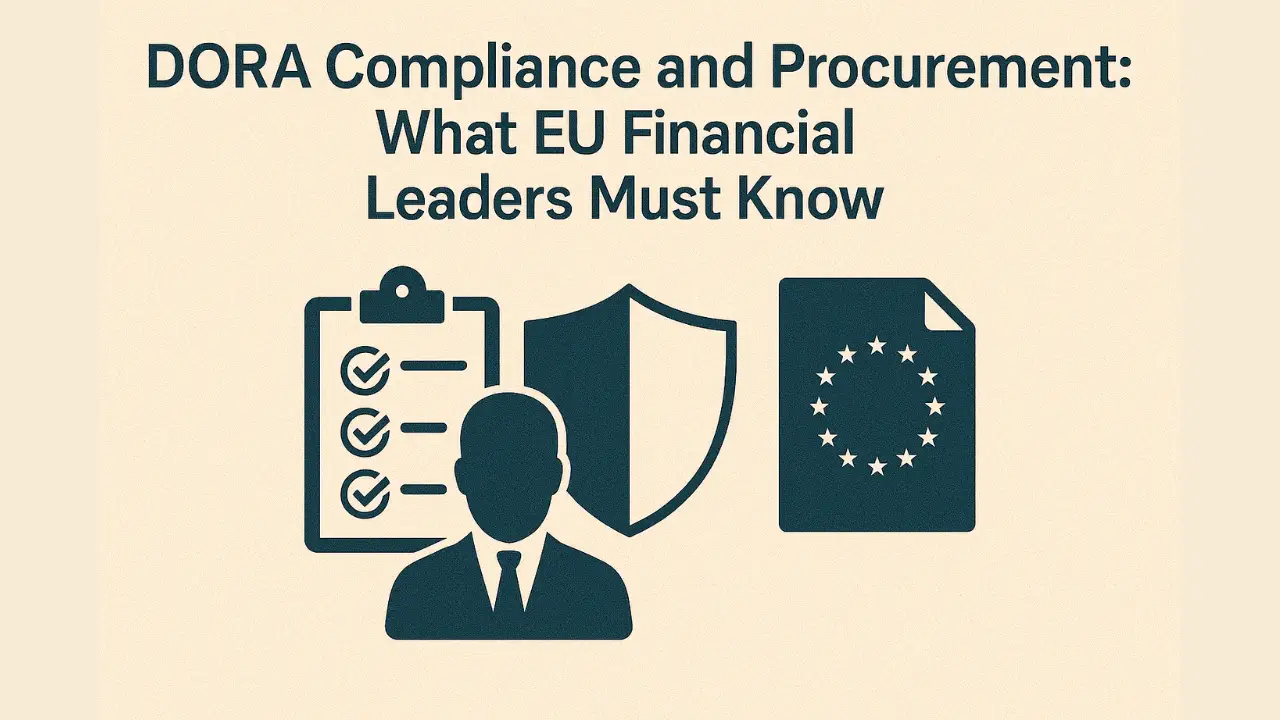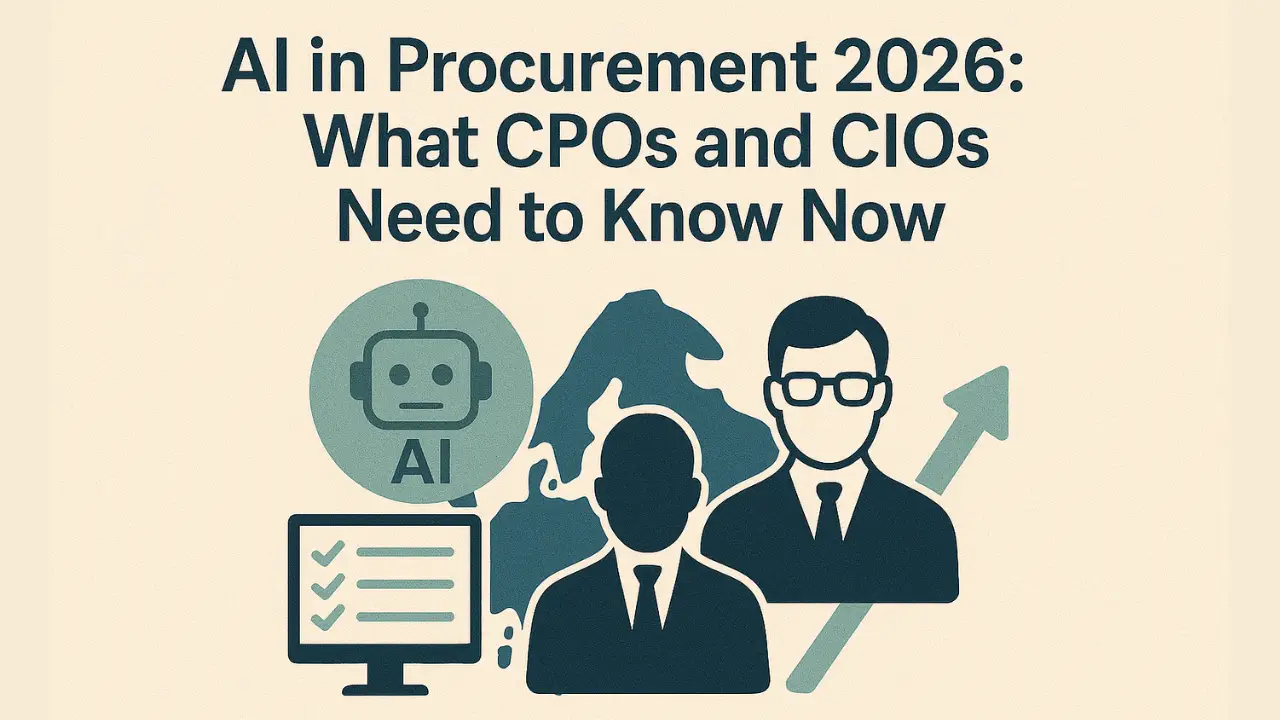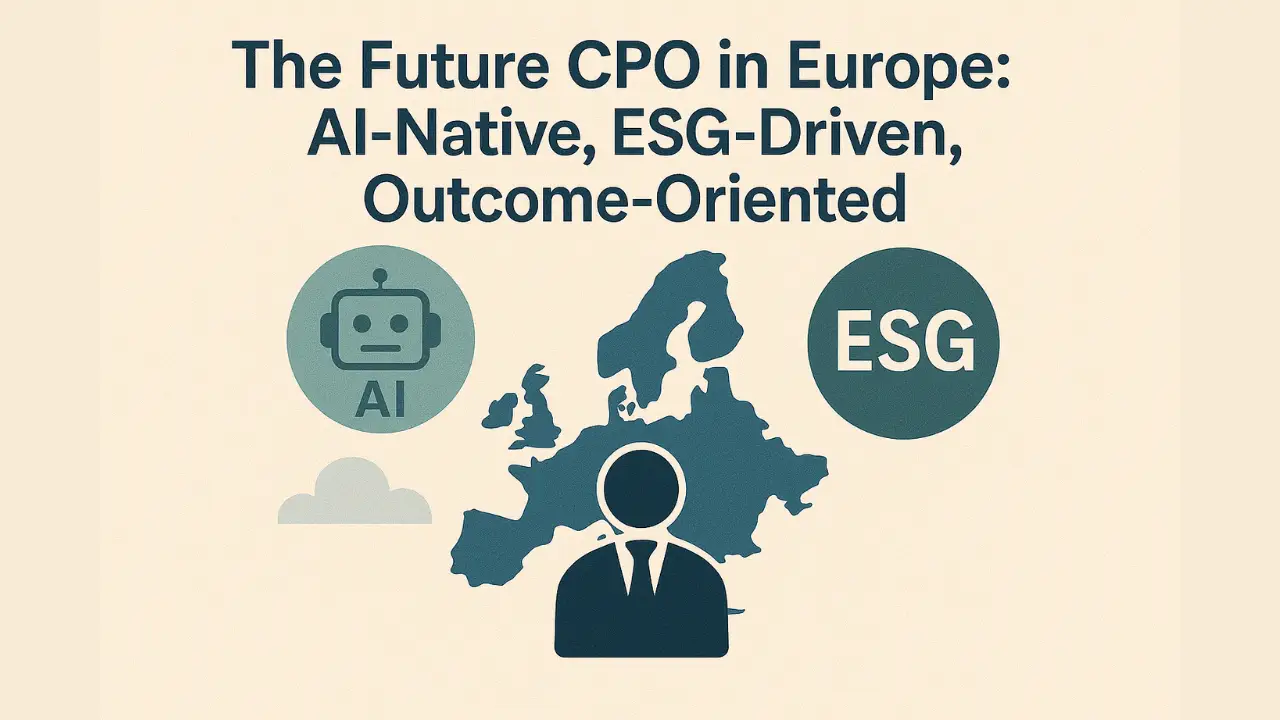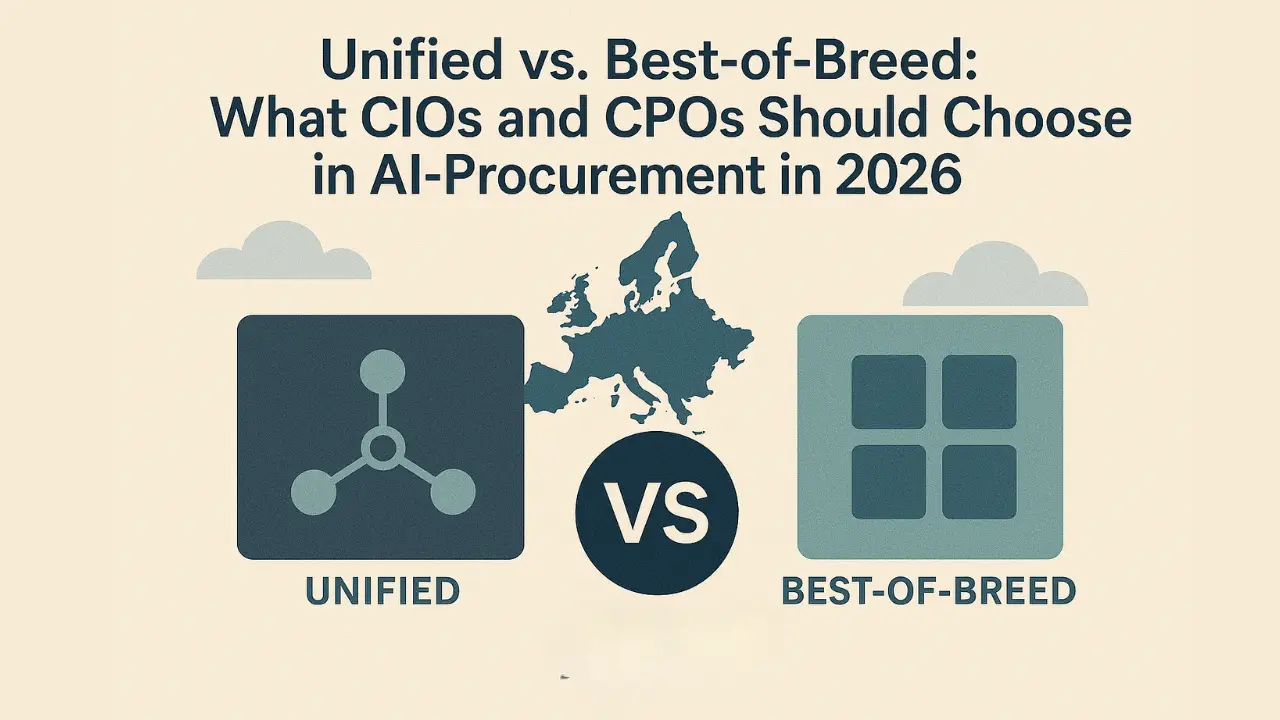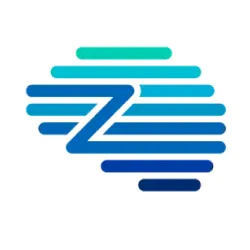Procurement is no longer just about sourcing goods at the lowest cost. In a market rife with supply volatility, regulatory change, ESG demands, and accelerated digitization, procurement leaders must choose tools and strategies that balance flexibility, insight, and control. For CPOs and CIOs steering procurement in Europe, the wrong tool can become a liability. Below is a guide you can use to sharpen vendor evaluation, avoid common pitfalls, and invest in future-proof procurement capabilities, along with how Zycus’s latest platform updates align with that future.
TL;DR
- The European CPO Buyer Guide 2025 highlights how procurement leaders must adapt to AI, ESG mandates, and regulatory shifts shaping the market.
- AI in procurement is moving from automation to intelligence, tools must reason, predict, and act under governance and transparency frameworks.
- European CPOs and CIOs should prioritize unified data models, interoperability, explainable AI, and measurable business outcomes.
- ESG tracking, supplier risk monitoring, and auditability are now core buying criteria, not add-ons.
- Zycus’s Merlin Agentic AI Platform empowers buyers with predictive insights, sustainability intelligence, and governed autonomy.
- The right procurement platform will help European enterprises future-proof against complexity, regulation, and rapid digital evolution.
The Shifting Landscape: Why Your 2026 Buying Criteria Must Change
As many analysts and procurement trend surveys show, several shifts have deepened complexity:
- AI moves from automation to predictive intelligence. Procurement systems must surface insights, detect risk, and suggest actions rather than just streamline tasks.
- ESG and supply chain transparency are steadily becoming non-negotiable. As the CSRD and EU regulation expand, procurement must bake sustainability into every decision.
- Risk management now demands continuous alerting, geopolitical, supplier, climate, cyber. Static assessments no longer suffice.
- Integration and orchestration matter: Best-of-breed modules often fail to scale when you layer them on heterogeneous systems.
In short, your procurement tech choice must be as much about future adaptability as about current feature sets.
Core Criteria for the Modern European Procurement Buyer
When evaluating platforms or vendors in 2026, weigh heavily on these dimensions:
1. Data Backbone & Unified Model
A shared canonical data model across suppliers, contracts, spend, risk, ESG metrics is essential. Agents or modules that operate over fragmented or inconsistent data will propagate errors.
Look for systems that enforce validation and reconciliation, and permit data governance layers to be actively managed.
2. Agentic Intelligence & Autonomy (Under Guardrails)
You want tools that do more than automate: you want agents that recommend, act, and orchestrate across workflows, but under policy guardrails and human oversight.
Examine vendor roadmaps: how far do their “intelligent agents” go? Do they reason across modules or stay siloed? How mature is their human-in-loop architecture?
3. Interoperability & Extension Strategy
Today’s buyer must think modular, but not disconnected. A platform must allow extension to niche modules, partner tools or custom functions, all while preserving governance, audit and coherence.
Check whether the vendor offers APIs, event buses, or “AppXtend” layers to plug in vertical or domain extensions.
4. Governance, Auditability & Explainability
Especially in Europe, you must embed traceability, decision logs, override routes, and model explainability into any AI module you deploy.
Ask vendors for sample audit logs, model rationale, decision trails, and case studies of how they handled exceptions.
5. Value Outcomes vs. Feature Count
Don’t be dazzled by feature checklists alone. Adopt a use-case centric view: what outcomes (cycle time cuts, risk reduction, ESG compliance, savings) does this solution deliver, and how will you measure that?
Vendors that can show live customer metrics, before/after dashboards, and benchmarks carry more weight.
6. Vendor Stability & Innovation Pace
Deploying procurement tools is a long-term commitment. Prioritize vendors who are investing in R&D, pushing agentic AI, recognized by analysts, and who have a cohesive roadmap, not just incremental updates.
How Zycus Aligns with 2025 European Buyer Priorities
At Zycus, our product strategy is built exactly around the criteria above. Here’s how our recent innovations respond to your priorities:
Merlin Agentic AI Platform: the Intelligent Core
Zycus’s Merlin Agentic AI Platform is a low-code orchestration layer where admins can configure intelligent agents across sourcing, contracting, supplier performance, procurement analytics and more. All agents run on a unified data graph and standardized APIs.
By February 2025, Zycus officially launched the Merlin platform to bring autonomous and semi-autonomous agents into everyday procurement workflows. The goal: accelerate cycles by up to 50%, while preserving governance.
Agentic AI Modules for Key Domains
- Contract Management: Agents help in drafting, compliance checking, risk flagging and renewal throughput.
- Supplier Performance & Risk: Autonomous monitoring, enrichment of supplier profiles, tier-2 linkages, continuous risk insights.
- Sourcing Automation & Global Sourcing: From supplier discovery to event orchestration, agents make sourcing more strategic and responsive.
- Sustainable Procurement: Tracking ESG compliance, monitoring supplier impact, and flagging nonconformity centrally.
- Procurement Analytics: Real-time insights, exception detection, anomaly alerts guiding procurement shifts.
Recognition & Industry Momentum
Zycus is gaining external validation. It has been named a top global agentic AI company by Procurement Magazine. Firms and analysts are beginning to refer to Zycus as among the few vendors delivering production-grade autonomous agents across the source-to-pay lifecycle.
Suggested Roadmap for Buying Smarter in 2026
- Pilot with a high-impact use case (e.g. tail-spend negotiation, contract renewal) but ensure your platform supports extensibility.
- Define your success metrics upfront (cycle time, savings, risk alerts, ESG outcomes).
- Demand agent transparency and audit logs from your vendors, especially for contracts or risk decisions.
- Layer in governance from day one, with review boards, human overrides, exception workflows.
- Verify that modules interoperate e.g. sourcing, contract, supplier, analytics, do you see conflicting outputs?
- Check vendor R&D commitment and analyst recognition, you want your vendor to evolve, not stagnate.
Final Thoughts
The 2026 procurement market will reward buyers who think beyond modules and toward intelligence, governance and strategy. The right tool is no longer the one with the most features, but the one that evolves your organization, surfaces risk, accelerates outcomes, and scales with clarity.
With its agentic-first architecture and modular AI modules, Zycus directly addresses the core buying criteria of this new era. If you select your procurement platform by how well it orchestrates intelligence, not just automates tasks, you will position your organization ahead of disruption rather than chasing it.
FAQs
Q1. Why is 2026 a pivotal year for procurement technology?
Because AI, ESG compliance, and supply volatility demand more intelligent, adaptive, and auditable procurement systems built for continuous transformation.
Q2. What should CPOs prioritize when choosing a platform?
Focus on data unification, agentic AI capabilities, interoperability, explainability, and measurable value outcomes — not just feature lists.
Q3. How is Zycus adapting to 2026 buyer needs?
Through the Merlin Agentic AI Platform, which unifies sourcing, contract, supplier, and analytics modules under a low-code, agentic architecture.
Q4. What are the biggest pitfalls to avoid in procurement tech buying?
Siloed data models, lack of governance, poor integration between modules, and over-reliance on unexplainable AI agents.
Q5. What’s the long-term advantage of agentic AI in procurement?
Agentic AI enables self-learning, predictive, and autonomous orchestration across procurement workflows — ensuring speed, transparency, and resilience.
Related Reads:
- Success Story: European Hotel Group Experiences Increased Productivity Through A Stable And Scalable Zycus P2P Solution
- Watch Video: Driving procurement resilience amidst economic downturn & uncertainty: A European Perspective
- Research Report: Ten Megatrends and insights for the European CPOs
- Source-to-pay vs Procure-to-pay: A Guide
- How S2P Applications Supercharge Your Bottom Line
- Source To Pay Optimization in Procurement: Benefits and Best Practices
- Your Guide to Source-to-Pay
- You Can’t Miss these 7 European Procurement Best Practices

